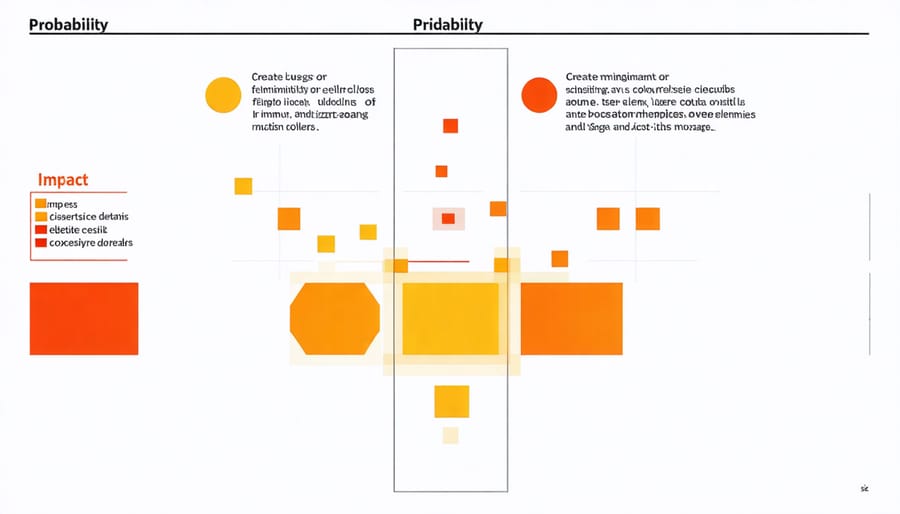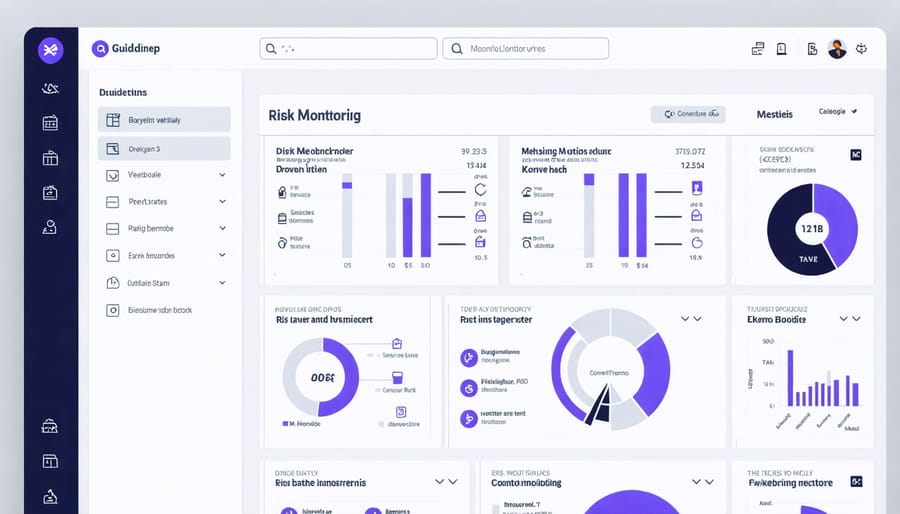In today’s complex construction landscape, implementing a robust construction risk management plan stands as the cornerstone of project success. Construction professionals who master the six-step risk management process gain a significant competitive advantage, reducing costly setbacks and ensuring project delivery within scope and budget.
Recent industry data reveals that 30% of construction projects fail due to inadequate risk assessment, while companies implementing structured risk management protocols report a 25% reduction in project delays and cost overruns. From groundbreaking to project completion, each phase demands systematic risk evaluation and strategic mitigation measures.
This comprehensive guide breaks down the essential steps of construction risk management, incorporating real-world case studies and expert insights from leading industry professionals. Whether managing a small-scale renovation or overseeing a multi-million dollar development, these proven strategies will help you identify, assess, and control project risks with precision and confidence.
Follow these methodically designed steps to transform potential threats into manageable challenges and create a resilient framework for project success.
Step 1: Risk Identification
Common Construction Risk Categories
Construction projects face various risk categories that must be carefully evaluated and managed throughout the project lifecycle. Technical risks encompass design errors, construction methodology issues, and equipment failures that can impact project execution. These often stem from complex architectural requirements or challenging site conditions that demand innovative solutions.
Financial risks include cost overruns, payment delays, market fluctuations, and currency exchange variations. These can significantly affect project viability and must be assessed during the initial planning phases. Careful consideration of contingency funds and insurance coverage is essential for mitigating financial exposure.
Environmental risks involve weather-related delays, geological challenges, and environmental compliance issues. Climate considerations, soil conditions, and local environmental regulations can substantially impact project timelines and costs. Additionally, sustainable construction requirements and environmental protection measures must be factored into risk assessments.
Safety risks remain paramount in construction projects, encompassing worker safety, public protection, and site security. These include potential accidents, health hazards, and structural safety concerns during construction. Implementing comprehensive safety protocols and maintaining strict compliance with occupational safety standards is crucial for risk mitigation.
Risk Identification Tools
Effective risk identification relies on a combination of proven tools and methodologies commonly used in construction projects. Comprehensive checklists serve as systematic guides, ensuring no potential risks are overlooked during the assessment phase. These checklists typically cover areas such as site conditions, regulatory compliance, resource availability, and technical specifications.
Structured brainstorming sessions bring together diverse project stakeholders, including contractors, engineers, and site supervisors, to identify potential risks from multiple perspectives. These collaborative meetings often uncover unique risks that might not be apparent through individual analysis, particularly in complex construction projects.
Historical data analysis provides valuable insights from past projects, helping teams identify patterns and recurring risks. This includes reviewing project documentation, incident reports, and lessons learned from similar construction endeavors. Construction firms often maintain databases of previous risk events, their impacts, and mitigation strategies implemented.
Additional identification tools include site surveys, expert interviews, and SWOT analysis specific to construction scenarios. Regular safety audits and compliance reviews also contribute to ongoing risk identification throughout the project lifecycle, ensuring new risks are captured as they emerge.

Step 2: Risk Assessment
Qualitative Risk Analysis
Qualitative risk analysis employs a probability and impact matrix to assess identified risks systematically. This matrix evaluates risks based on their likelihood of occurrence and potential impact on project objectives, typically using a scale from “very low” to “very high.” Construction professionals utilize this tool to categorize risks into priority levels, enabling more informed decision-making.
The matrix typically presents probability on one axis and impact on the other, creating a visual representation of risk severity. For instance, a structural design flaw might have a low probability but catastrophic impact, while material price fluctuations may have high probability but moderate impact. This assessment helps project teams allocate resources effectively and prioritize response strategies.
Key factors considered during qualitative analysis include schedule constraints, budget implications, safety considerations, and regulatory compliance. Project managers should engage relevant stakeholders during this assessment phase to leverage collective expertise and ensure comprehensive risk evaluation. This collaborative approach helps validate risk ratings and ensures alignment with project objectives while maintaining practical feasibility in the construction context.

Quantitative Risk Analysis
Quantitative risk analysis employs numerical methods and statistical modeling to assess construction risks with greater precision. This data-driven approach helps organizations develop effective project loss reduction strategies through mathematical evaluation of risk probability and impact.
Key components include Monte Carlo simulation, sensitivity analysis, and expected monetary value (EMV) calculations. These tools enable project managers to quantify potential cost overruns, schedule delays, and resource allocation issues. For instance, Monte Carlo simulation can model thousands of project scenarios, providing probability distributions for various outcomes and helping teams make informed decisions about risk mitigation investments.
Construction firms typically utilize specialized risk analysis software to process historical project data, current market conditions, and expert assessments. This analysis generates concrete metrics such as risk-adjusted contingency budgets, probability-weighted schedule impacts, and cost-benefit ratios for different risk response options. The resulting quantitative insights allow stakeholders to prioritize risks objectively and allocate resources more effectively across the project lifecycle.
Step 3: Risk Prioritization
Once risks have been identified and assessed, the next crucial step is prioritizing them based on their potential impact and likelihood of occurrence. This process enables project teams to allocate resources effectively and focus on the most critical threats to project success.
The widely accepted Risk Priority Number (RPN) method combines severity, probability, and detectability scores on a scale of 1-10. Multiply these factors to determine each risk’s RPN score, with higher numbers indicating priorities requiring immediate attention. For instance, a structural integrity issue might score 8 for severity, 6 for probability, and 4 for detectability, resulting in an RPN of 192.
Industry best practices recommend using a risk matrix, also known as a probability-impact grid, to visualize risk priorities. This tool plots risks on a 5×5 grid where the vertical axis represents probability and the horizontal axis shows impact severity. Risks falling in the high-probability, high-impact quadrant demand immediate action and detailed mitigation plans.
Consider both quantitative and qualitative factors when prioritizing risks. While financial impact is crucial, also evaluate factors like safety implications, regulatory compliance, schedule delays, and reputation damage. A seemingly minor structural issue could have severe safety implications, warranting higher prioritization despite lower direct costs.
Document your prioritization methodology clearly and review it regularly with stakeholders. This ensures transparency in decision-making and allows for adjustments as project conditions evolve. Remember that risk priorities aren’t static – they should be reassessed periodically throughout the project lifecycle to maintain their relevance and effectiveness.
Step 4: Risk Response Planning
Risk Response Strategies
Once risks have been identified and assessed, construction professionals must implement appropriate response strategies. These strategies typically fall into four main categories: avoidance, transfer, mitigation, and acceptance.
Risk avoidance involves eliminating the threat entirely by changing project plans or approach. For example, deciding not to build in a geologically unstable area or choosing an alternative construction method to bypass potential hazards. While effective, avoidance may not always be practical or cost-effective.
Risk transfer shifts the responsibility and potential impact of risks to another party. Common transfer methods include purchasing insurance policies, implementing performance bonds, or establishing contractual agreements with subcontractors. However, it’s crucial to understand that transferring risk often incurs additional costs and doesn’t eliminate the risk itself.
Implementing risk mitigation strategies involves reducing either the probability of risk occurrence or its potential impact. This might include strengthening safety protocols, upgrading equipment, providing additional training, or implementing robust quality control measures. Mitigation often requires upfront investment but can significantly reduce long-term costs associated with risk incidents.
Risk acceptance acknowledges that some risks are unavoidable or that the cost of other response strategies outweighs potential benefits. This strategy can be active (developing contingency plans and budgets) or passive (accepting consequences without preparation). For instance, minor weather delays might be accepted as part of the project timeline, with contingency days built into the schedule.
The key to successful risk response lies in selecting the most appropriate strategy based on the risk’s nature, potential impact, and the project’s constraints. Regular monitoring and adjustment of these strategies ensure their continued effectiveness throughout the project lifecycle.
Step 5: Risk Monitoring
Risk monitoring represents the ongoing vigilance required to maintain effective risk management throughout a construction project’s lifecycle. This critical phase involves implementing systematic tracking mechanisms and establishing key performance indicators (KPIs) to evaluate the effectiveness of risk responses.
Modern construction projects increasingly rely on digital risk monitoring tools that provide real-time data analysis and automated alerts. These platforms enable project managers to track risk indicators, measure mitigation effectiveness, and identify emerging threats before they escalate into major issues.
Successful risk monitoring requires:
– Regular risk assessment reviews and updates
– Documentation of risk response outcomes
– Analysis of risk trigger events
– Performance measurement against established risk thresholds
– Continuous stakeholder communication
Industry best practices emphasize the importance of maintaining a risk register that tracks both resolved and ongoing risks. This living document should be updated regularly with new information, changing conditions, and lessons learned from risk responses.
Project managers should establish clear reporting protocols and schedule periodic risk review meetings with key stakeholders. These sessions provide opportunities to assess the effectiveness of current risk controls and adjust strategies as needed.
Construction firms that excel in risk monitoring typically integrate their monitoring systems with project management software, enabling seamless data collection and analysis. This integration helps identify patterns and trends that might indicate developing risks, allowing for proactive rather than reactive risk management.

Step 6: Risk Review and Update
The final step in the risk management process is not an endpoint but rather a continuous cycle of review, evaluation, and improvement. Regular monitoring of implemented risk control measures ensures their effectiveness and allows for timely adjustments when necessary. Construction projects are dynamic environments where new risks can emerge as conditions change, making this step crucial for maintaining project safety and efficiency.
Industry best practices recommend quarterly reviews of risk management strategies, with additional assessments triggered by significant project changes or near-miss incidents. These reviews should examine the performance of existing control measures, analyze new data from site inspections, and evaluate emerging industry trends that might impact risk profiles.
Documentation plays a vital role in this phase. Maintain detailed records of risk assessments, incident reports, and control measure effectiveness. This data becomes invaluable for future projects and helps establish organizational learning. Construction firms that excel in risk management typically implement a formal feedback system where project teams can report challenges and suggest improvements to existing protocols.
Consider implementing key performance indicators (KPIs) to measure the effectiveness of your risk management program. These might include metrics such as incident frequency rates, cost savings from risk prevention, and response times to identified hazards. Regular stakeholder meetings should be scheduled to discuss these metrics and adjust strategies accordingly.
Remember that external factors, such as new regulations, technological advancements, or changes in industry standards, may necessitate updates to your risk management approach. Stay connected with industry associations and regulatory bodies to ensure your risk management practices remain current and compliant.
In conclusion, the six-step risk management process provides construction professionals with a systematic framework to identify, assess, and control potential threats to project success. By following these steps – risk identification, analysis, evaluation, treatment, monitoring, and review – organizations can significantly reduce their exposure to uncertainties while maximizing opportunities for project optimization.
The effectiveness of this process lies in its iterative nature and comprehensive approach. Through diligent application of these steps, construction teams can better anticipate challenges, allocate resources efficiently, and maintain project momentum even when faced with unexpected obstacles. Industry statistics consistently show that organizations implementing structured risk management processes experience fewer cost overruns, shorter delays, and improved stakeholder satisfaction.
Remember that successful risk management requires commitment from all project stakeholders and regular updates to risk assessments as project conditions evolve. By integrating these six steps into your project management methodology, you create a robust foundation for project success while demonstrating professional due diligence and industry best practices. Make this process a cornerstone of your project planning to ensure consistent, reliable project outcomes and enhanced organizational resilience.

